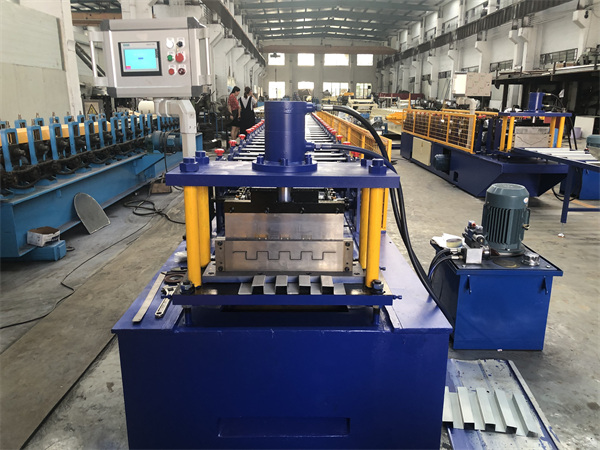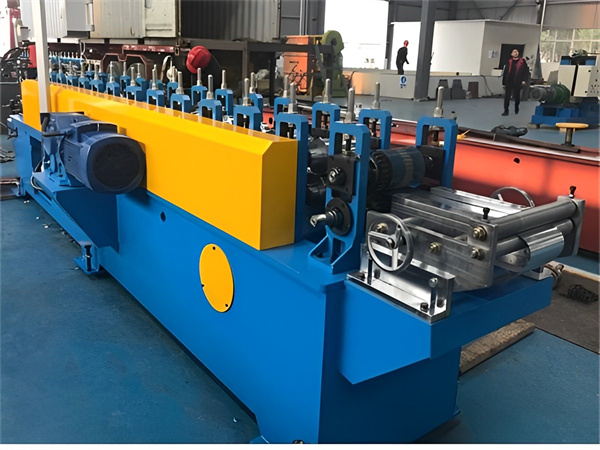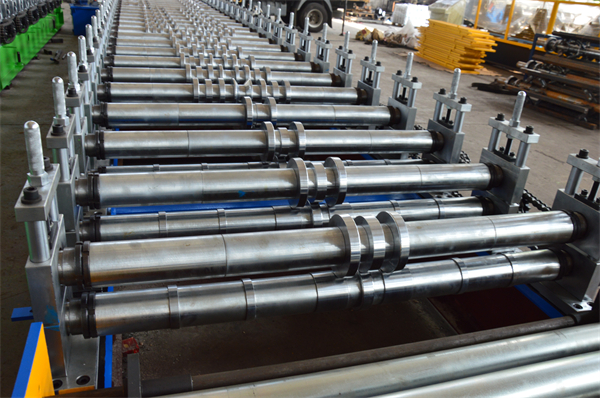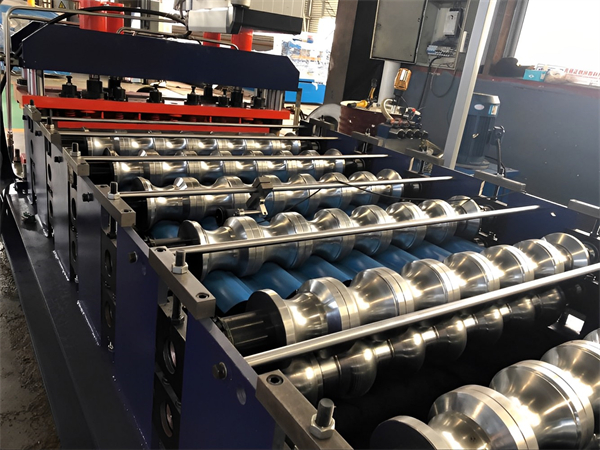1. Introduction
In the realm of construction and manufacturing, efficiency and precision are paramount. The drywall stud roll forming machine has emerged as a game-changer in the field, revolutionizing the process of producing drywall studs. This article delves into the intricacies of drywall stud roll forming machines, their benefits, features, operation, maintenance, and more.
2. Understanding Drywall Stud Roll Forming
1. What is Roll Forming?
Roll forming is a metalworking process that involves continuous bending of a long strip of metal to create desired cross-sections. This process is integral to the production of drywall studs, where uniformity and accuracy are crucial.
2. Drywall Studs: A Vital Component
Drywall studs are vertical frames that provide structural support for interior walls and ceilings. Traditional methods of producing these studs involve cutting and welding, which can be time-consuming and imprecise. Enter the drywall stud roll forming machine—a revolutionary technology that streamlines the manufacturing process.

3. Benefits of Using a Drywall Stud Roll Forming Machine
Roll forming machines bring an array of benefits to the construction industry:
1. Enhanced Precision
The automated nature of these machines ensures consistent measurements and shapes for every stud produced, minimizing wastage and errors.
2. Speedy Production
Drywall stud roll forming machines can churn out studs at an impressive pace, significantly accelerating project timelines.
3. Material Efficiency
The process minimizes material waste as it precisely shapes each stud from a continuous coil of metal, optimizing material usage.
4. Cost Savings
While the initial investment might seem substantial, the long-term cost savings in terms of labor, material, and rework make it a financially sound decision.
5. Versatility in Design
Modern roll forming machines offer customization options, allowing for variations in stud design based on project requirements.
Stay tuned for the second part of this article, where we will explore the key features to consider when choosing a drywall stud roll forming machine for your needs.
4. Key Features to Look for in a Drywall Stud Roll Forming Machine
When investing in a drywall stud roll forming machine, it’s crucial to consider various features that will impact its performance and your overall productivity.
1. Material Compatibility
Ensure that the machine can work with the specific type and thickness of metal you intend to use for your drywall studs. Different machines may have limitations in terms of material compatibility.
2. Roll Tooling Design
The roll tooling design plays a significant role in shaping the studs. Look for machines with adjustable roll tooling that can accommodate different stud profiles and sizes.
3. Automation and Controls
Modern machines come equipped with advanced automation and control systems that allow for precise adjustments, quick setup changes, and real-time monitoring of the production process.
4. Production Speed
Consider the machine’s production speed and how it aligns with your project requirements. While faster machines can boost efficiency, ensure that speed doesn’t compromise the quality of the studs.
5. Durability and Maintenance
A well-built, durable machine can withstand the rigors of continuous production. Additionally, easy maintenance procedures can minimize downtime and keep the machine in optimal condition.

5. Choosing the Right Drywall Stud Roll Forming Machine for Your Needs
1. Evaluating Your Production Volume
Assess the volume of drywall studs you anticipate producing. If you have high production demands, investing in a machine with higher output capacity is essential to avoid bottlenecks.
2. Customization Options
Consider whether the machine offers customization options for different stud profiles and sizes. This is particularly important if you work on projects with varying specifications.
3. Return on Investment (ROI)
Calculate the potential ROI by comparing the savings in labor, material, and time against the initial investment cost of the machine. In most cases, the ROI becomes evident over time.
4. User-Friendly Interface
Opt for a machine that offers an intuitive interface for operators. This reduces the learning curve and minimizes the chances of errors during setup and operation.
6. Step-by-Step Guide to Operating a Drywall Stud Roll Forming Machine
Operating a drywall stud roll forming machine involves a systematic process to ensure safety and quality output. Here’s a step-by-step guide:
Step 1: Material Loading
Load the metal coil onto the machine’s unwinding mechanism, ensuring it feeds smoothly into the forming section.
Step 2: Set Roll Tooling
Adjust the roll tooling based on the desired stud profile. Follow manufacturer guidelines for proper adjustments.
Step 3: Set Parameters
Using the machine’s control panel, input the necessary parameters such as stud length, width, and thickness.
Step 4: Start Production
Initiate the machine and monitor the initial studs closely to ensure they meet the required specifications.
Step 5: Quality Control
Regularly inspect the studs produced to identify any deviations from the desired profile. Make necessary adjustments if required.
Step 6: Continuous Monitoring
Throughout production, monitor the machine’s performance and make any real-time adjustments to maintain quality and efficiency.
7. Maintenance and Care of Your Drywall Stud Roll Forming Machine
Ensuring the longevity and consistent performance of your drywall stud roll forming machine requires regular maintenance and proper care.
1. Scheduled Inspections
Set up a schedule for routine inspections. Check for wear and tear on roll tooling, belts, and other critical components. Address any issues promptly to avoid production interruptions.
2. Lubrication
Proper lubrication of moving parts is essential to prevent friction-related problems. Follow the manufacturer’s guidelines for lubrication frequency and use recommended lubricants.
3. Cleaning
Keep the machine clean from debris, dust, and metal shavings that can accumulate during production. Regular cleaning prevents buildup that could affect performance.
4. Calibration Checks
Periodically verify the accuracy of the machine’s settings and measurements. Recalibrate as necessary to maintain precise stud dimensions.

8. Common Issues and Troubleshooting
Even with proper maintenance, issues can arise. Here are some common problems and their potential solutions:
1. Uneven Stud Profiles
Issue: Studs are coming out with uneven shapes.
Solution: Check the roll tooling for misalignment or damage. Adjust or replace the tooling as needed.
2. Material Jamming
Issue: Metal coil gets stuck during feeding.
Solution: Ensure the coil is properly aligned and unwinds smoothly. Check for any obstructions in the feeding mechanism.
3. Excessive Noise
Issue: Unusual noise during operation.
Solution: Inspect the machine for loose components. Lubricate moving parts if necessary. If noise persists, consult a technician.
9. Safety Precautions When Using a Drywall Stud Roll Forming Machine
Prioritize safety to protect operators and maintain a smooth production process:
1. Operator Training
Provide comprehensive training to machine operators, covering both operation and safety protocols.
2. Personal Protective Equipment (PPE)
Ensure operators wear appropriate PPE, including safety glasses, gloves, and hearing protection.
3. Emergency Stop
Install easily accessible emergency stop buttons on the machine to quickly halt operations in case of a problem.
10. Future Trends in Drywall Stud Roll Forming Technology
As technology advances, we can expect the following trends in drywall stud roll forming:
1. Smart Automation
Integration of AI and data analytics for real-time monitoring and predictive maintenance.
2. Eco-Friendly Materials
Greater emphasis on sustainable materials and processes in response to environmental concerns.
3. Remote Monitoring
Remote access and control capabilities for improved machine management and troubleshooting.
Stay tuned for the last part of this article, where we’ll explore case studies showcasing successful applications of drywall stud roll forming machines.
11. Case Studies: Successful Applications of Drywall Stud Roll Forming Machines
Real-world examples highlight the effectiveness of drywall stud roll forming machines in various projects:
1. Commercial Office Building
In a large-scale commercial office building construction, a drywall stud roll forming machine significantly expedited the framing process. The machine’s precision ensured consistent stud profiles, enhancing structural integrity and reducing on-site adjustments. The project was completed ahead of schedule, showcasing the machine’s time-saving capabilities.
2. Residential Renovation
During a residential renovation project, a drywall stud roll forming machine allowed for quick customization of stud profiles to accommodate irregular wall dimensions. The flexibility and speed of the machine facilitated seamless integration of new walls into the existing structure, minimizing disruption to the occupants.

12. Cost Analysis: Is Investing in a Drywall Stud Roll Forming Machine Worth It?
The decision to invest in a drywall stud roll forming machine should be guided by a comprehensive cost analysis. Consider the following factors:
1. Initial Investment
Factor in the cost of the machine, installation, and any necessary training.
2. Operating Costs
Include expenses such as maintenance, energy consumption, and replacement parts.
3. Labor Savings
Estimate the reduction in labor hours required for stud production.
4. Material Savings
Calculate the optimization of material usage provided by the precise roll forming process.
FAQs
Q1: How do I know if a drywall stud roll forming machine is right for my business? A: Assess your production volume, customization needs, and long-term goals. If these align with the capabilities of the machine, it’s likely a good fit.
Q2: Can the machine accommodate different metal types? A: It depends on the machine’s specifications. Many machines can handle various metals, but it’s essential to verify before purchasing.
Q3: What maintenance does the machine require? A: Regular inspections, lubrication, and cleaning are crucial. Follow the manufacturer’s guidelines for maintenance procedures.
Q4: Are roll forming machines suitable for small-scale projects? A: While roll forming machines are often associated with larger projects, there are compact models suitable for small-scale operations.
Q5: How long does it take to see a return on investment? A: The time frame varies based on factors such as production volume and cost savings, but many businesses start seeing returns within a couple of years.
